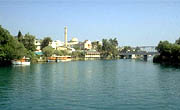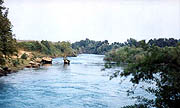Manavgat...
The foundation of
Manavgat is not known certain, but estimated at B.C. 200-150. As
understood from the early documents, cargo and human transportation had
been made on the river, from the very first centuries till recent years.
Manavgat has become a village of Turkish Republic at 1913.
The town Manavgat, which
is 76 km far from the province Antalya. was founded on the plain that
lies on both sides of the River Manavgat. The city center is 4 km far
from the shore of the Mediterranean. The Northern part of the town is
bordered by the Taurus Mountains covered with beautiful forests. The
river Manavgat, which flows through the town, givesthe plain fertility
and richness. The Manavgat Waterfall and its delta are the most
important natural richness of the town. The other natural beauties of
the region in the South are the Sorgun Forest with pine trees and the
lake "Titreyengöl", which was formed by alluvions that filled the delta
of the River Manavgat.
In the Northern part of
the river Manavgat there is the Lake of Oymapınar Dam. It was built in
the deep valley of the river in the Taurus Mountains. The Dam and its
surroundings have a unique beauty. The region is one of the places for
Jeep Safaris the plain of Manavgat, which is 2500 m2. is the most
fertile plain of the province Antalya and is suitable for growing cotton,
wheat, barley and 45 different kinds of fruit and vegetables. Fruit and
vegetables growing in greenhousees in an important from of farming in
the region. Greenhouse flowering has also improved recently. In the far
East of the plain bananas are grown in the gardens. Trout and shrimps
are bred in some parts of the river. During the recent years parallel to
the growth of tourism, losts of modern hotel motels and holiday villages
have been built in the region o Sorgun and Titreyengöl. The history of
the town is known to be very old and it is believed that the name
Manavgat comesfrom the word "Munouwa" in the old language of luwi,
meaning temple of matrilineal Goddess. The place was supposed to be used
as the sacred area of the Antique cities Seleukeia and Side in different
periods.
 |
 |